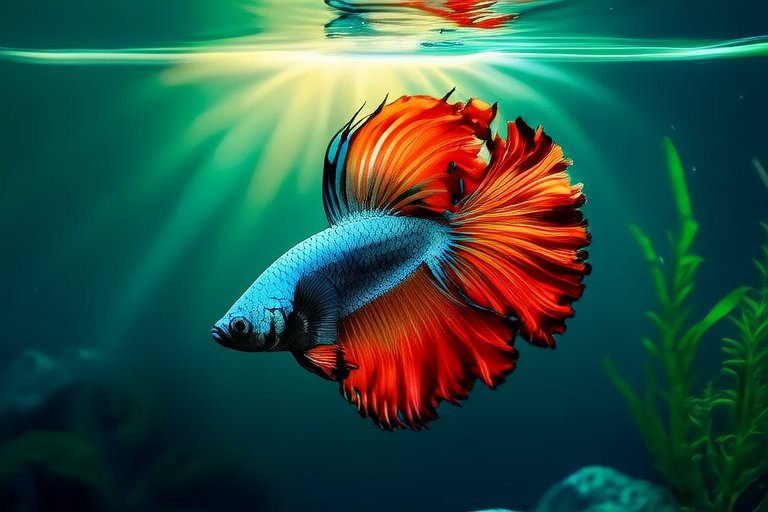Hidden Behaviors and Lesser-Known Facts About Betta Fish
Betta fish, often referred to as Siamese fighting fish, are popular among aquarists due to their vibrant colors and flowing fins. However, many aspects of their behavior and care are often overlooked by aquarium guides. This article explores the hidden behaviors, complex social structures, unique health needs, and environmental sensitivities of betta fish, providing insights into their natural habitat, social dynamics, and optimal care.
Natural Habitat
Betta fish originate from the warm, shallow waters of Thailand, Cambodia, Vietnam, and Malaysia. These environments are characterized by dense vegetation, low oxygen levels, and fluctuating water conditions. In the wild, bettas live in rice paddies, drainage ditches, and slow-moving streams. Their ability to survive in such challenging conditions is attributed to their labyrinth organ, which allows them to breathe atmospheric air. This adaptation is crucial for their survival in poorly oxygenated waters.
Complex Social Structures
Despite common misconceptions, betta fish are not solitary creatures. In their natural habitat, they form complex social structures, often living in small groups or pairs. Male bettas establish territories and engage in ritualistic displays to defend their space and attract mates. Females also exhibit social behaviors, forming schools and interacting with one another. Understanding these social dynamics is essential for creating an enriching environment in home aquariums.
Unique Health Needs
Betta fish have specific health needs that require careful attention. Maintaining optimal water parameters, including temperature, pH, and hardness, is crucial for their well-being. Betta fish thrive in temperatures between 76°F and 82°F (24°C and 28°C) and prefer slightly acidic to neutral water with a pH range of 6.5 to 7.5. Regular water changes and filtration are necessary to prevent the buildup of harmful substances, such as ammonia and nitrite. Additionally, bettas are sensitive to sudden changes in water chemistry, so it’s important to acclimate them gradually when introducing new water.
Tips for Enriching Lives Through Proper Tank Setup
To create a thriving environment for betta fish, consider the following tank setup tips:
- Size: While bettas can survive in smaller tanks, providing at least five gallons of water ensures adequate swimming space and promotes overall health.
- Filtration: Choose a filter that provides gentle water circulation without overwhelming the betta. Overly strong currents can cause stress and disrupt their natural behaviors.
- Hiding Spots: Incorporate plants, caves, and other decorations to offer hiding spots and create a sense of security.
- Water Quality: Perform regular water changes and monitor water parameters to maintain a stable and healthy environment.
Companionship Considerations
Contrary to popular belief, betta fish can coexist with other species under certain conditions. However, it’s crucial to select compatible tankmates carefully. Avoid aggressive or fin-nipping fish, such as tiger barbs and certain cichlids. Instead, opt for peaceful species like neon tetras, ghost shrimp, and snails. It’s important to note that male bettas are territorial and may become aggressive towards other males. Therefore, housing multiple males together is generally not recommended.
Dietary Preferences
Betta fish are carnivorous and require a diet rich in protein. In the wild, they feed on insects, insect larvae, and small crustaceans. In captivity, provide a balanced diet consisting of high-quality betta pellets, freeze-dried bloodworms, and occasional treats like brine shrimp. Avoid overfeeding, as excess food can contribute to poor water quality and health issues. Feed bettas once or twice daily, offering only what they can consume within two minutes.
Myths About Betta Fish Being Solitary Creatures
The myth that betta fish are solitary creatures stems from their aggressive behavior towards other males and their ability to thrive in small spaces. However, this does not mean they are naturally solitary. In fact, bettas are social animals that benefit from interaction with other species. Providing companionship can help reduce stress and promote overall well-being. When introducing new tankmates, observe their interactions closely and be prepared to separate them if conflicts arise.
Intelligence and Environmental Sensitivity
Betta fish are intelligent and can recognize their owners and respond to stimuli. They demonstrate problem-solving abilities and can learn simple tasks, such as locating food sources. Their sensitivity to their environment makes them excellent indicators of water quality. Any changes in behavior, such as lethargy, loss of appetite, or unusual swimming patterns, may signal underlying issues that require attention.
Challenges of Maintaining Water Quality
Maintaining water quality is one of the most significant challenges in keeping betta fish. Poor water quality can lead to various health problems, including fin rot, swim bladder disorders, and respiratory issues. To ensure a thriving environment, follow these guidelines:
- Regular Water Changes: Perform partial water changes (25-30%) weekly to remove waste and maintain water clarity.
- Monitor Parameters: Use test kits to monitor water parameters, such as pH, ammonia, nitrite, and nitrate, and make adjustments as needed.
- Air Stones: Incorporate air stones to increase oxygen levels, especially in smaller tanks.
- Heaters: Maintain a stable temperature using heaters, particularly during colder months.
Breeding Habits
Breeding betta fish requires careful planning and attention to detail. Male bettas build bubble nests to house their eggs and provide parental care. To encourage breeding, create a suitable environment with appropriate water parameters and introduce a mature pair. Once spawning occurs, remove the female to prevent harassment. The male will tend to the eggs until they hatch, typically after three days. After hatching, the fry will remain in the nest for several days before becoming free-swimming. At this point, feed them infusoria or commercially available fry food.
In conclusion, understanding the hidden behaviors and lesser-known facts about betta fish is essential for providing optimal care and enhancing their quality of life. By acknowledging their natural habitat, complex social structures, unique health needs, and environmental sensitivities, aquarists can create enriching environments that support their well-being. With proper tank setup, companionship considerations, and dietary preferences, betta fish can thrive in home aquariums, showcasing their vibrant colors and fascinating behaviors.
